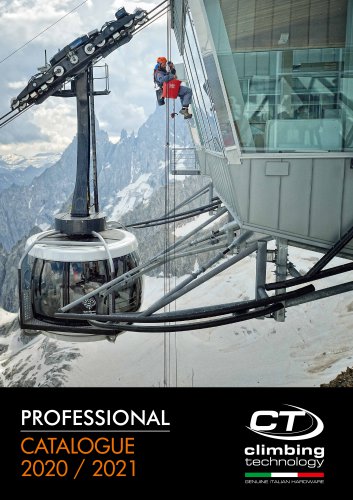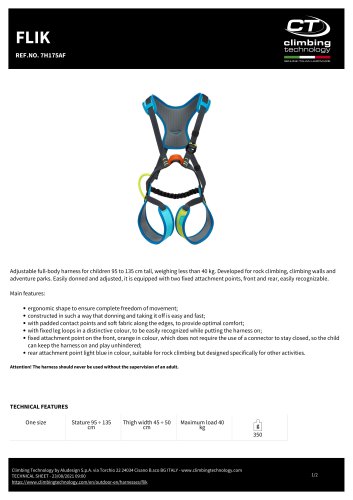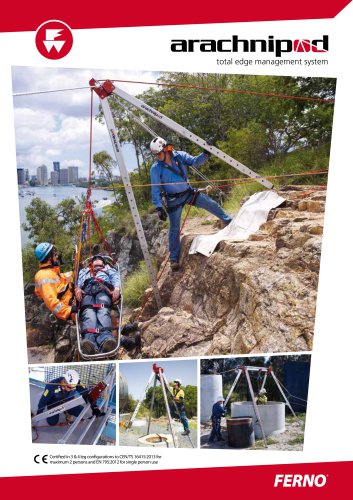 Website:
Climbing Technology
Website:
Climbing Technology
Catalog excerpts

CLIMBING EQUIPMENT CATALOGUE 2019 GENUINE ITALIAN HARDWARE
Open the catalog to page 1
CLIMBING PASSION: TRUE PASSION CAN ONLY GROW. Climbing Technology as a brand holds and celebrates 30 years of passion and experience in the design and manufacturing of personal protective equipment. An accomplice has definitely been the territory, at the foot of the mountains between Bergamo and Lecco, where the mountaineering tradition is very strong, we settled here and set about developing our skills in metalwork and mechanics. In these 30 years we have breathed and developed an extensive know how and combined with the latest generation of manufacturing technology it has enabled us to...
Open the catalog to page 2
A. D’Addario - Terminal, Albenga Klaus Dell’Orto _ Climbing Technolog
Open the catalog to page 3
For a long time we have wanted to include in our catalogue a practical explanation of how best to use our products. This is not intended to be a manual nor to substitute a formal climbing course, but simply to give our customers, and friends, a summary of the main activities involved in climbing and mountaineering. For us, safety is a constant, absolute “must”. This attitude drives us to invent, produce and sell products which are safe. A safe product isn’t just one which functions correctly and which meets the legal standards: a safe product is functional, logical, ergonomic, long-lasting,...
Open the catalog to page 4
A - SINGLE-PITCH SPORT CLIMBING “Sport climbing” means climbing with already-existing fixed protection points, so as to guarantee the maximum safety in case of a fall. Most (but not all) sport climbing is on single-pitch routes whose length is up 35/40 m. The routes are bolted by enthusiasts or in some cases by people whose job it is to bolt the routes. Each route consists of: • a series of fixed intermediate anchors, expansion or glue-in bolts; • the end of the route and the point you lower-off from, the “belay” or “lower-off”. To climb a route, someone must “lead” it, that means they must...
Open the catalog to page 5
LEADING. (g) The successive steps in leading a single-pitch route are shown. 1 - Buddy check. A checks that B has correctly connected the belay device to his har- f ness and passed the rope correctly through the belay device. B checks A's knot. 2 - Leading. B belays, paying out rope to A who climbs up the route, clipping a quickdraw onto each bolt and the rope into the quickdraw. 3 - At the belay. A has arrived at the end of the route and has threaded the rope through the lower-off. 4 - Lowering-off. B pays out the rope through the belay device to lower A back down to the ground....
Open the catalog to page 6
A3 - PREPARING TO CLIMB Two people are need to sport climb, one who climbs (A) and the other who belays (B). Before starting climbing, a series of actions ensure safety: • A and B choose the route to climb, making sure their rope is of adequate length. It must be at least twice the length of the route; • A feeds the rope into an orderly pile on the rope bag, making sure there are no knots. She ties a knot in the end of the rope; • A and B put on their harnesses and helmets correctly; • A ties the rope into her harness with a figure of eight knot while B connects the belay device to his...
Open the catalog to page 7
The figure of eight knot is the safest and easiest to tie knot for attaching the rope to the climber’s harness. To tie it follow the steps shown in the diagram to the left making sure that the rope passes through both the waist loop and the loop joining the leg loops. Make sure the knot is tied correctly and at least 1012 cm of free end of the rope is left sticking out. A3.3 - TYING THE KNOT IN THE END OF THE ROPE A - SINGLE-PITCH SPORT CLIMBING A3.2 - TYING THE FIGURE OF EIGHT KNOT PRACTICAL EXPLANATIONS PRACTICAL EXPLANATIONS A - SINGLE-PITCH SPORT CLIMBING The knot in the end of the rope...
Open the catalog to page 8
A4 - BELAYING THE LEADER Belaying the leader involves paying out rope through the belay device to the leader (A), holding the rope in case of a fall and then lowering the leader back to the ground once she has climbed the route. This lets the leader climb the route in safety. To belay well, the belayer (B) should: • be able to use the belay device properly; • belay themselves to the ground/nearby crag if they are much lighter than the leader (A) or if there is a risk of them falling off an exposed ledge from which they are belaying; • pay constant attention to the leader (A) as she climbs...
Open the catalog to page 9
PRACTICAL EXPLANATIONS A - SINGLE-PITCH SPORT CLIMBING A4.2 - RELEASING THE ROPE To start paying out again rope to the climber after she has hung on the rope or after a fall, keep holding the free end of the rope with one hand and with the other hold the Click Up+ and lift it upwards, so as to return the belay karabiner to its initial position. This unblocks the device and you can pay out rope again. Lowering the other climber. Take in rope and lock the Click Up+. Keeping one hand all the time on the free end of the rope, with the other hold the Click Up+ as shown in the diagram and with...
Open the catalog to page 10
A5 - LEADING “Leading” is when the climber (A) climbs up the route using the natural hand- and footholds present in the rock and clipping the rope into the quickdraws clipped onto the bolts to protect herself in case of a fall. In order to climb safety the leader (A) should: • be correctly tied into the rope and the belayer (B) should belay attentively; • be aware of her own capabilities and know the appropriate climbing techniques; • be able to clip the quickdraw onto the bolt and then the rope into the quickdraw, as correctly as possible; • be able to thread the belay. The following...
Open the catalog to page 11
In the following pictures: 1) Correct situation, the gate is away from the direction of climbing and the rope come up through and out of the karabiner. 2) Potentially dangerous situation: because the climber’s rope is running in the same direction as the gate of the krab. 3) Real danger: the karabiner is back-clipped and, due to the climber changing direction, accidents could be caused (Figs. 3.1-3.2). 4) Real danger, becuase the karabiner is back-clipped and the gate is facing the same direction as the rope. DANGER DANGER In situation 3.1 a mistaken clip (back-clip) and the subsequent...
Open the catalog to page 12All Climbing Technology catalogs and technical brochures
-
Catalog PROFESSIONAL 2020 / 2021
196 Pages
-
Catalog OUTDOOR 2021
120 Pages
-
EXPLORER
2 Pages
-
FLIK
2 Pages
-
MOON
3 Pages
-
CLASSIC-K SLIDER
2 Pages
-
Brochure ARACHNIPOD
8 Pages
-
Catalogo PROFESSIONAL 2017
196 Pages
-
Catalog PROFESSIONAL 2018
180 Pages
-
Catalog OUTDOOR 2018
196 Pages











